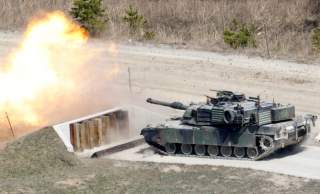The Army Has Special Plans For Its New M1A2C Tank
The world's most powerful tank is getting even better.
Key Points: The cost of the new armor and Trophy APS is greater turret weight, which is likely going to be several tons heavier than what the M1A2 was designed for.
The M1A2C, formerly known as the M1A2 SEPv3 is America’s most modern tank. The last major “version” of the M1A2 Abrams was developed in the mid-to-late 2000s, the M1A2 SEP v2.
This upgrade was primarily geared towards the urban combat the Abrams was facing at the time in Iraq. The SEPv2 added the Common Remotely Operated Weapons Station to the Abrams to allow the commander to shoot at targets from the safety of inside the tank, and improved the side and front armor of the tank with standard mounts for the Tank Urban Survival Kit set of add-on armor. It also added a tank-to-infantry phone for better coordination with a tank’s infantry screen.
Now, the recent changes to the SEP v3 standard appear to signal a return to a conventional warfare focus against a peer enemy. The latest iteration of the SEP v3 has thick add-on armor blocks on the front of the turret face, additional armor improvements, and a Trophy Active Protection System (APS) to defeat anti-tank missiles and rockets.
(This first appeared in March 2019.)
But how has the SEP v3 changed since we first heard of it? Will it likely see more updates as the standard is applies to the current fleet of tanks?
One of the first iterations of the M1A2 SEP v3 was showcased at the AUSA 2015 defense expo. The SEP v3 showcased here was a relatively conservative upgrade, replacing electronics with newer and superior versions and upgrading other subsystems like the thermal sight and auxiliary power unit. The biggest change on the 2015 SEP v3 was the new ammunition data link that enabled the use of the new M829A4 and XM1147 rounds.
This configuration remained largely the same. Articles from 2016 and 2017 showcase a tank that’s largely the same, although the Army’s officially announced 2017 configuration also includes a more advanced counter-IED electronic warfare package and improved radios. Six M1A2 SEP v3s were delivered in that configuration in October 2017.
The major shakeup in the SEP v3 began in 2018. In February 2018, it was announced that the Army would fit Israeli Trophy APS onto their tanks. This was brought about by the standing up of the Army’s new “Futures Command,” which is aiming to rapidly modernize the U.S. Army for a future peer conflict.
The first Trophy confirmed purchase was a retrofit of the systems to M1A2 SEP v2 tanks that were stationed in Europe, but it’s evident that since the breaking of that news, Trophy has been included in the SEP v3 standard. It’s possible that this may evolve into a different APS in the future in the M1A2D, or in future revisions of the M1A2C standard.
The SEPv3 acquired its new designation, M1A2C, in September 2018, following a complaint by the House Armed Services Committee that the SEP designations were too long and complicated. The future standard, M1A2 SEP v4 was designated M1A2D at the same time.
The latest possible change to the M1A2C standard was shown in February 2019, when a M1A2C prototype was pictured with additional armor plates added to the turret. The frontal turret armor is one of the thickest parts of an Abrams’ armor, meant to resist direct hits from enemy anti-tank weapons.
While the 2017 configuration was said to boast improved armor, those changes were likely incorporated into the armor matrix internal to the turret cheeks. The addition of an external plate probably is a result of the Army wanting even more protection. This latest prototype is the most heavily armored Abrams yet, with the addon turret armor and armored skirts on the side of the hull.
The cost of the new armor and Trophy APS is greater turret weight, which is likely going to be several tons heavier than what the M1A2 was designed for. This may result in problems with the turret motor, which will likely be upgraded (or is being upgraded) in the next revision of the M1A2C standard.
Charlie Gao studied Political and Computer Science at Grinnell College and is a frequent commentator on defense and national security issues.
This article first appeared in March 2019. It is being republished due to reader interest.
Image: Reuters.

